June 22, 2025

The article emphasizes the significant benefits of Total Task Chaining in ABA therapy, showcasing how this method not only enhances skill acquisition but also fosters independence among clients. By allowing learners to engage with all steps of a task simultaneously, Total Task Chaining leads to improved task completion rates and heightened motivation. Furthermore, this approach enables clients to generalize their skills to real-life situations, illustrating its practical value. Such advantages are critical for those seeking effective strategies in ABA therapy, prompting a deeper consideration of how Total Task Chaining can be integrated into practice.
Total task chaining represents a transformative approach in Applied Behavior Analysis (ABA) therapy. This method shifts the focus to teaching individuals through the completion of entire tasks rather than isolated steps. Not only does this enhance skill acquisition and independence, but it also fosters a collaborative environment between therapists and clients, ultimately leading to improved outcomes.
As the field continues to evolve, however, questions arise regarding the long-term effectiveness and adaptability of total task chaining across diverse learning styles. How can practitioners leverage this powerful technique to maximize engagement and ensure the skills learned are effectively generalized to real-life situations?
The demand for (BCBAs) has surged dramatically, with an astonishing 1,942% increase from 2010 to 2018. This trend is expected to continue, with projections indicating a further rise of 25% by 2026. In this rapidly expanding field of Applied Behavior Analysis (ABA) therapy, Hire ABA serves as a specialized recruitment platform that connects BCBAs with top-tier job opportunities.
Are you facing challenges in finding qualified professionals? Hire ABA streamlines the hiring process through personalized resume assessments, ensuring that skilled individuals find roles that align with their expertise and career aspirations. Our team employs advanced job fit scoring to evaluate each resume, identifying opportunities that match the skills, preferences, and desired locations of BCBAs. This efficiency not only benefits job seekers but also enhances the quality of care delivered to individuals in .
Notably, California accounted for 18% of the demand for BCBAs in 2023, highlighting regional variations that healthcare employers must consider in their recruitment strategies. Furthermore, the integration of technological advancements in ABA therapy underscores the importance of specialized recruitment, as it allows for improved service delivery and client engagement.
By focusing on these critical aspects, Hire ABA ensures that qualified professionals are matched with roles that leverage their expertise. This ultimately contributes to improved outcomes in behavioral health services. Take action today and discover how Hire ABA can transform your recruitment process.
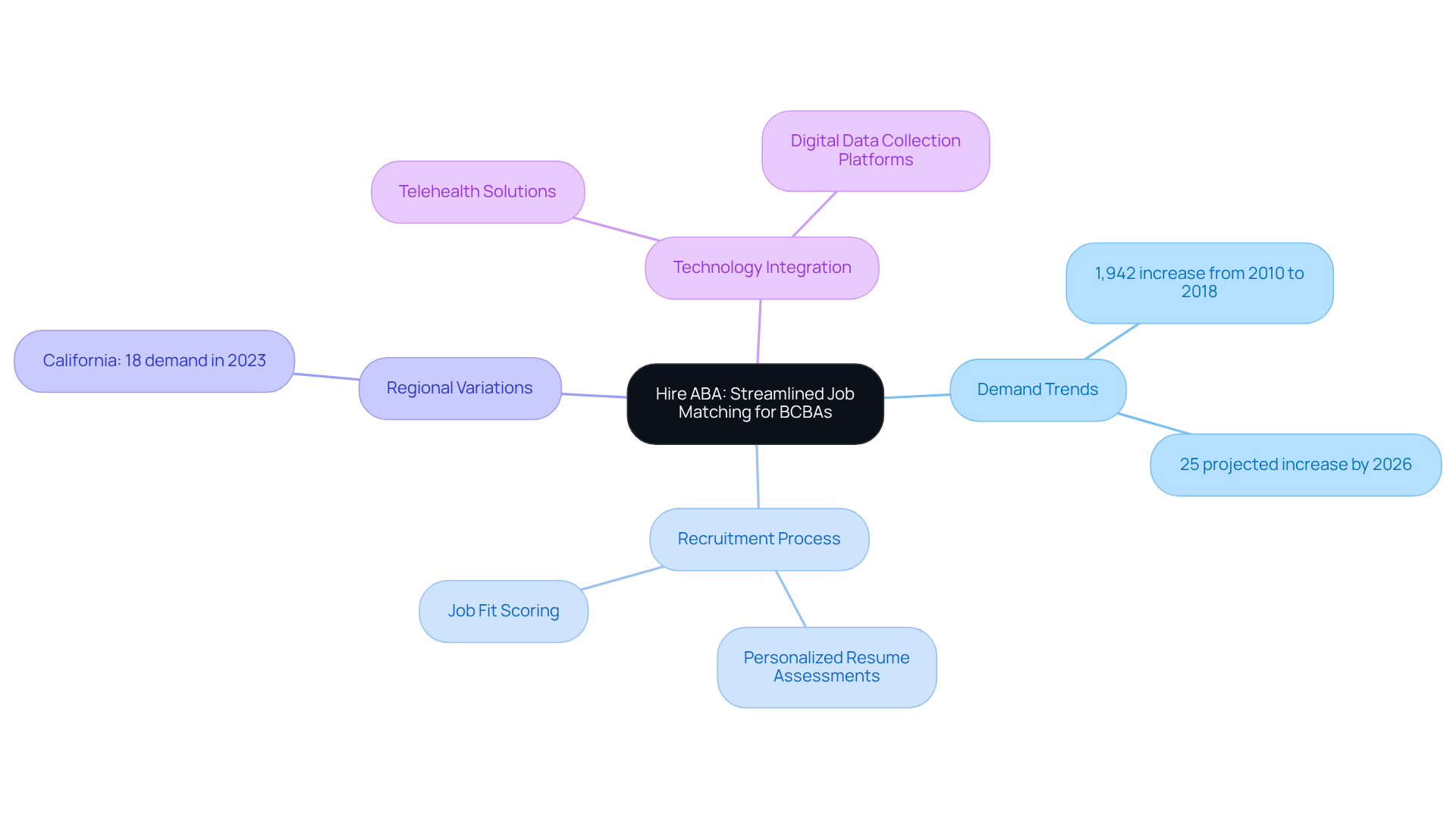
Comprehensive Activity Linking significantly enhances skill development by enabling learners to engage with simultaneously. This holistic approach provides immediate context and relevance, facilitating a deeper understanding of how each step contributes to the overall objective. Research indicates that this method not only aids in skill retention—up to 90% of youth undergoing ABA therapy exhibit noticeable improvements in —but also fosters the application of learned behaviors in real-life scenarios. By practicing total task chaining, individuals can cultivate a more comprehensive skill set, which is crucial for effective functioning across various environments.
The advantages of total task chaining extend beyond mere skill development; they encompass enhanced generalization of abilities. Students become more adept at applying what they have rehearsed in real-life situations. This method aligns with findings that underscore the importance of structured routines, as children thrive in organized environments. Consistent practice reinforces learned behaviors, ultimately leading to improved performance and independence. Ongoing participation from caregivers is vital, as their involvement significantly bolsters the efficacy of comprehensive task sequences.
However, it is essential to recognize that only 4% of studies on ABA therapy incorporated control groups, raising questions about the robustness of the findings regarding its effectiveness. This highlights the need for continued research and a critical evaluation of existing methodologies in the field.
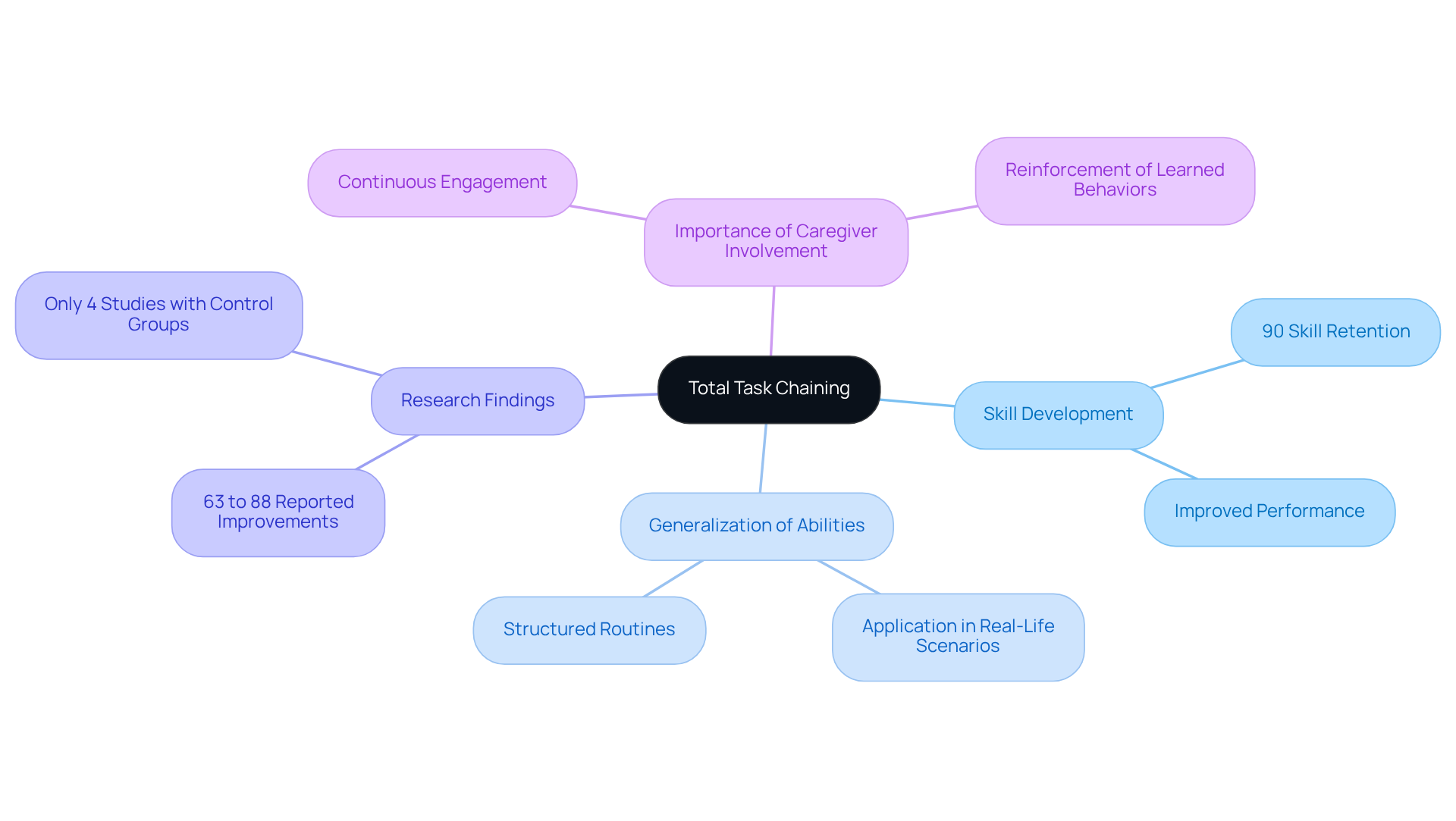
Complete Activity Linking stands as a compelling method within ABA therapy, significantly promoting independence by guiding individuals through the execution of tasks from start to finish. This technique empowers individuals to take ownership of their actions, fostering a profound sense of accomplishment and self-reliance.
As individuals successfully master various tasks, they build confidence in their abilities—an essential component for their overall development and quality of life. Notably, a study involving 98 autistic children revealed significant improvements in language and social skills (p < 0.001) through .
When a customer learns to prepare a basic dish using Complete Activity Sequencing, they not only acquire a vital life skill but also experience the fulfillment that comes with independence. This approach enhances functional capabilities and encourages individuals to engage more fully in their daily lives, reinforcing their independence and self-esteem.
By focusing on the completion of activities, total task chaining effectively cultivates the skills necessary for individuals to navigate their environments independently, ultimately leading to enhanced self-sufficiency and a better quality of life.
Nevertheless, it is crucial to acknowledge the ongoing research gap concerning the long-term impact of ABA on quality of life, ensuring that interventions remain effective and relevant.
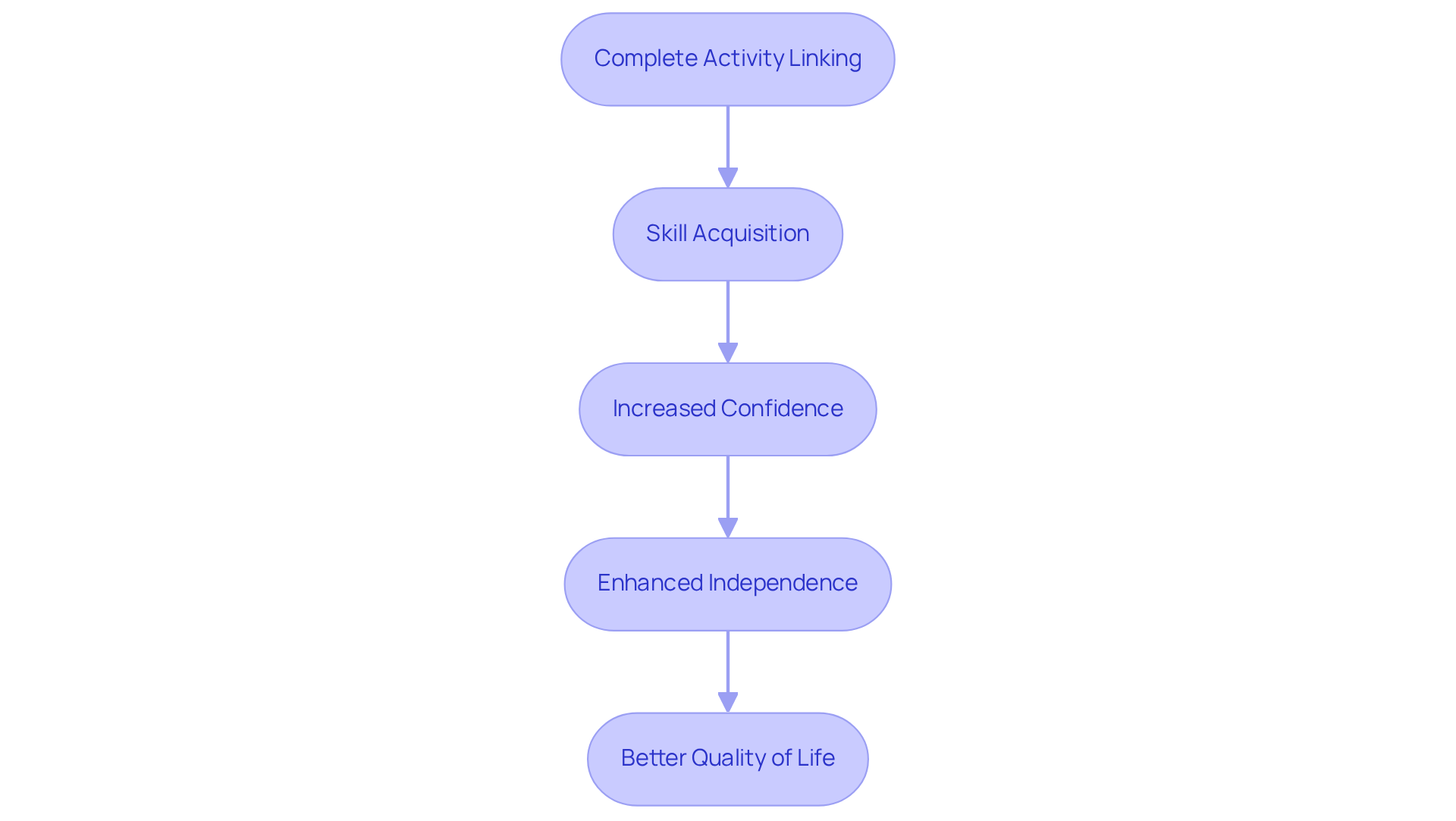
Comprehensive Activity Linking significantly enhances task completion efficiency through total task chaining, allowing learners to engage with all steps of an activity simultaneously. This approach minimizes the time spent on repetitive directions, allowing users to concentrate on mastering the entire series of actions. As a result, therapists can accomplish more in a shorter timeframe, leading to therapy sessions that are both more productive and effective.
Research indicates that implementing total task chaining can lead to a notable increase in task completion rates, with some practitioners reporting improvements of up to 30%. Furthermore, expert insights highlight that this method simplifies the learning process while fostering greater autonomy among individuals, empowering them to manage tasks independently without ongoing assistance.
Ultimately, integrating total task chaining into ABA therapy not only saves time but also improves the , making it a crucial strategy for practitioners looking to optimize their methodologies.
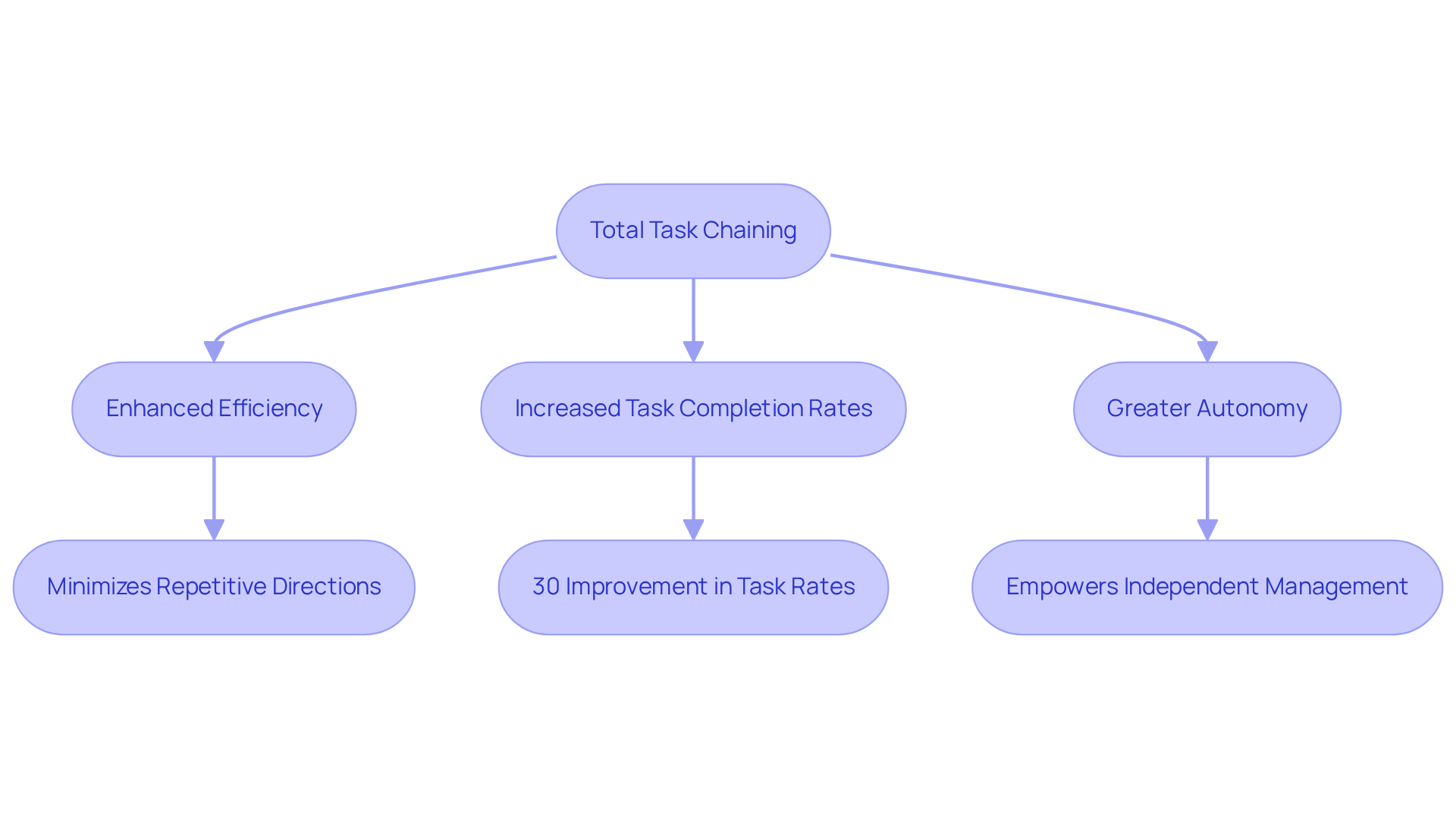
Comprehensive Activity Linking significantly enhances customer motivation by offering a structured and clear learning framework. This method allows individuals to track their progress as they complete entire tasks, fostering a sense of achievement that encourages continued participation in therapy.
Research indicates that organized learning strategies, such as Complete Activity Linking, lead to increased engagement and motivation among participants. For example, a study revealed that children receiving consistent reinforcement through task completion exhibited substantial improvements in adaptive behaviors, with an average increase of 4.46 points in adaptive behavior scores over 24 months of ABA therapy. Furthermore, the average adjusted ABC increase during this period was 2.49 points, underscoring the effectiveness of ABA interventions.
Additionally, integrating personal goals into Comprehensive Activity Linking not only aligns therapy with individual interests but also heightens motivation, as individuals are more inclined to engage when they see how their activities connect to their personal aspirations.
Expert insights affirm that prioritizing participant motivation is crucial for effective ABA practices, as motivated individuals are more likely to attain meaningful outcomes. Alarmingly, fewer than half (46%) of those who initiated ABA services remained engaged for 24 months, highlighting the challenges in sustaining participant involvement and the necessity for motivational strategies like Complete Activity Sequencing.
Ultimately, Comprehensive Activity Sequencing emerges as a , bolstering participant engagement and reinforcing the drive for success.
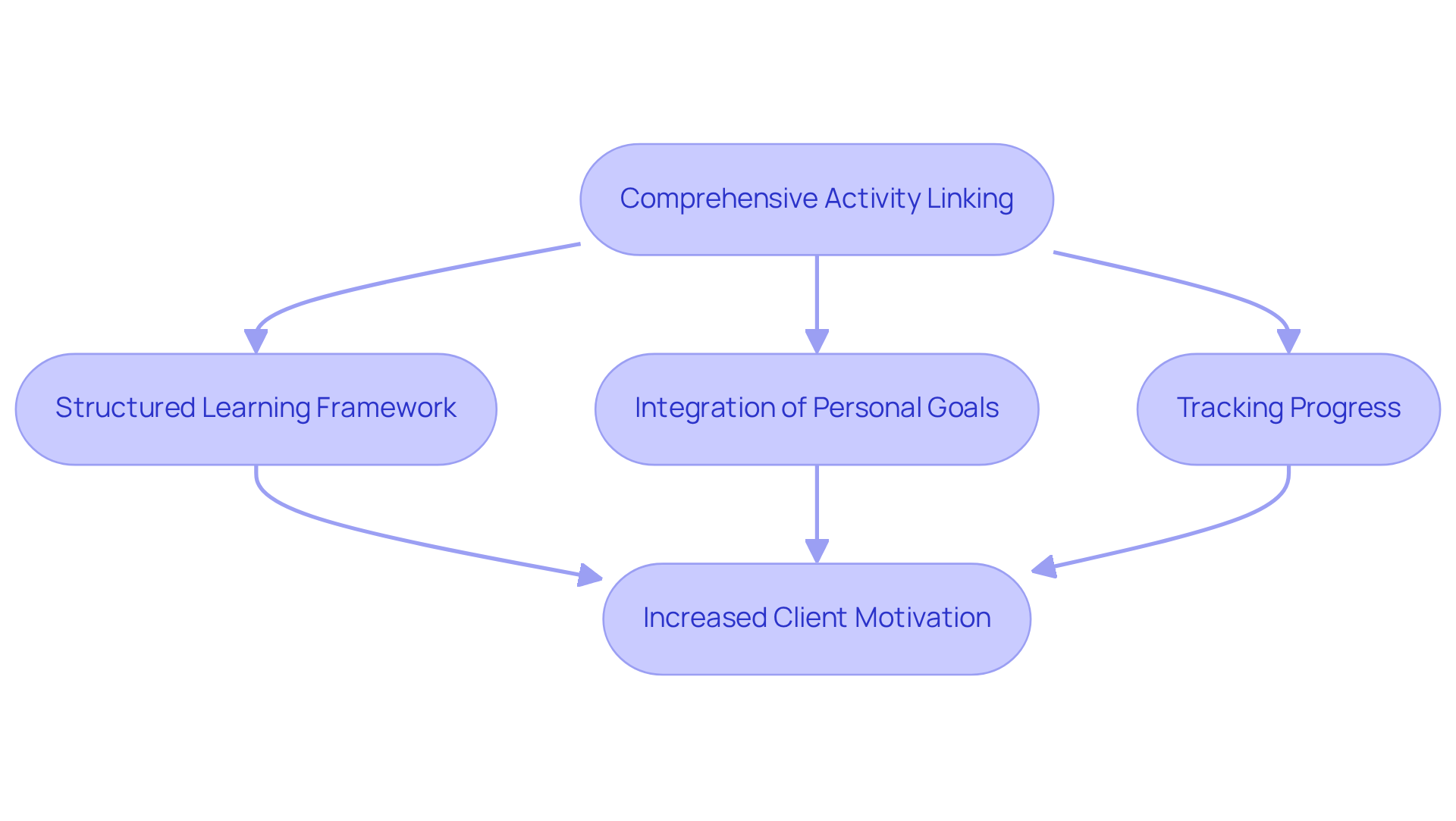
Complete Activity Sequencing stands out for its flexibility in accommodating various learning preferences. This adaptability enables therapists to based on specific user requirements. By teaching all steps of a task simultaneously, therapists can provide diverse support and prompts.
Have you considered how this tailored approach can enhance the learning experience for individuals? Each person receives the guidance necessary for their unique learning preferences, ultimately elevating the overall effectiveness of therapy. Such a method not only fosters independence but also ensures that therapy is both impactful and relevant.
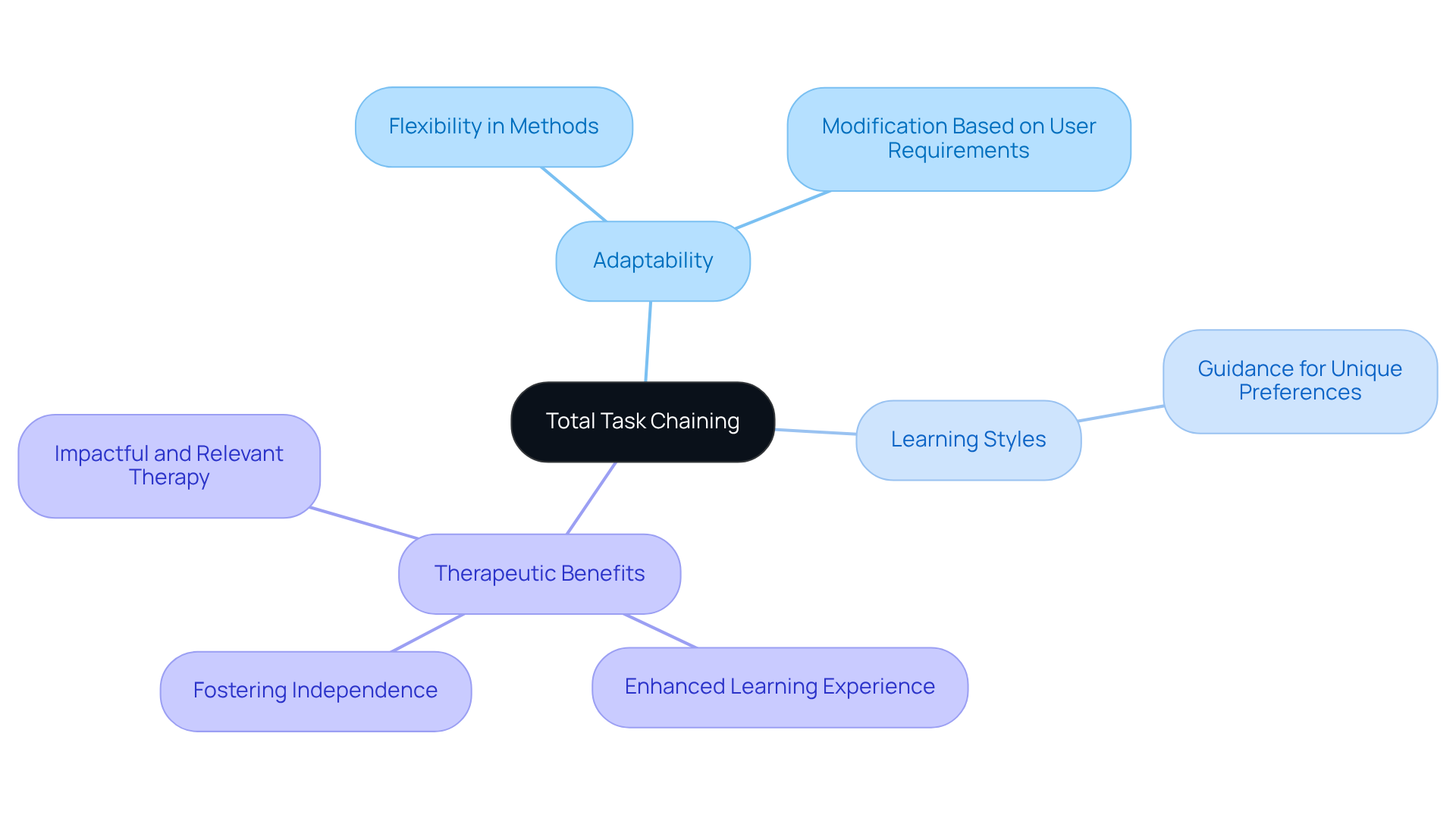
Complete Activity Sequencing employs a structured method to instruct intricate tasks by breaking them down into manageable parts. This approach clarifies the relationship between each step and the overall task while enhancing customer retention and mastery.
Research indicates that structured learning approaches in ABA therapy significantly improve task completion rates, with a meta-analysis revealing a standardized mean difference of d=0.30 for communication skills in children with ASD. Children engaged in total task chaining often exhibit heightened focus and improved memory capabilities; studies show that those receiving 36 hours or more of ABA therapy weekly demonstrate enhanced IQ and adaptive skills.
For example, when teaching a multi-step activity such as making a sandwich, each action—gathering ingredients, spreading condiments, and assembling the sandwich—is taught sequentially. This breakdown simplifies the , empowering users to navigate complex tasks with increased confidence.
Expert opinions emphasize that such task breakdowns are vital for effective skill acquisition, offering clear guidance and reducing cognitive load. As noted by O. Ivar Lovass, Ph.D., '90% of children exhibited significant progress after intensive ABA therapy,' underscoring the efficacy of organized methods like Complete Activity Sequencing.
Consequently, the structured nature of Comprehensive Activity Linking not only fosters autonomy but also positively impacts customer retention, as individuals witness tangible advancement and achievement in mastering new abilities.
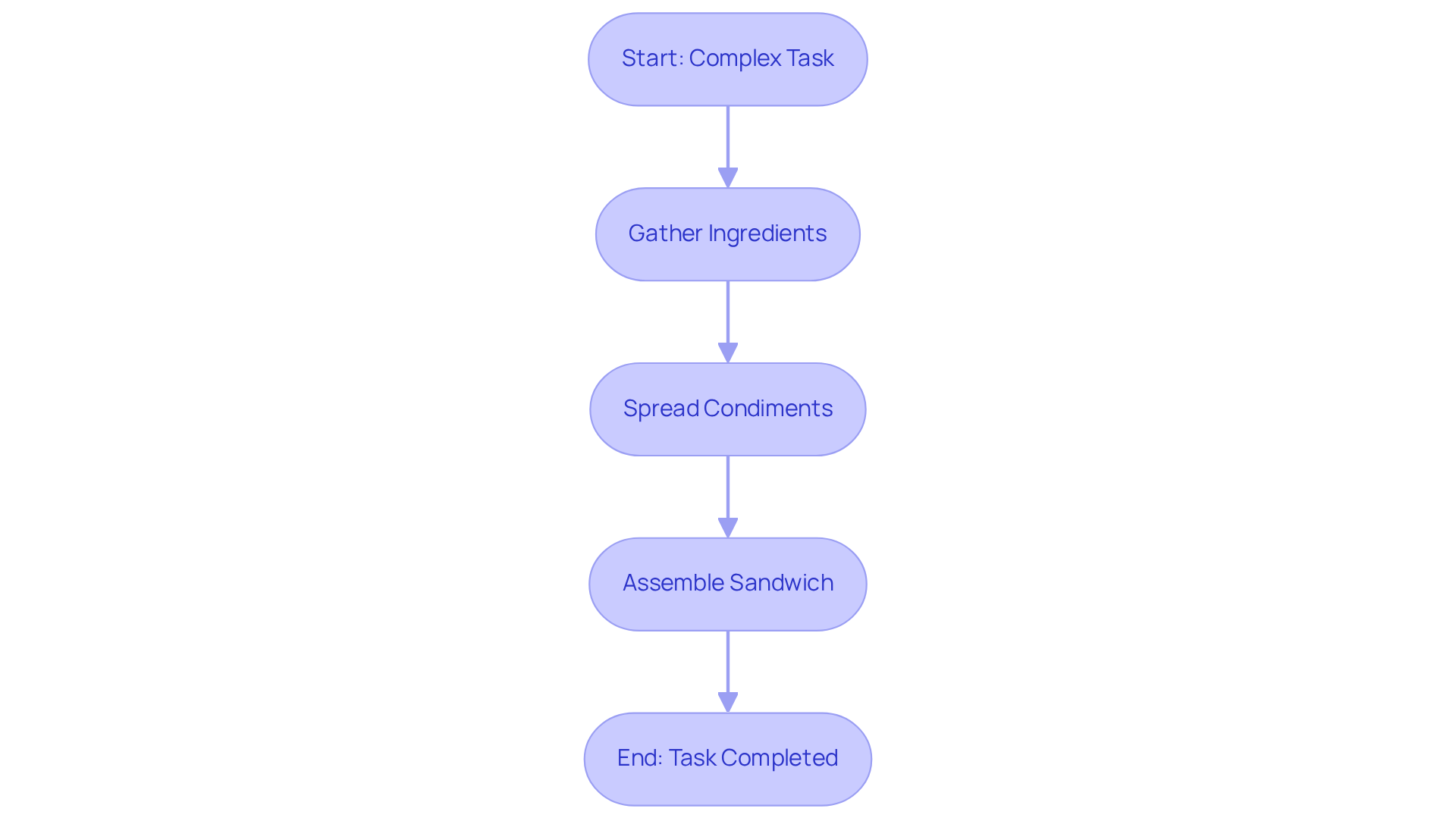
Complete Activity Linking stands as a highly effective approach in ABA therapy, significantly enhancing skill generalization by guiding clients to complete tasks in their entirety. This holistic methodology not only assists individuals in mastering specific skills but also guarantees the across various settings and situations. A compelling case study illustrates that children who practiced requesting snacks during therapy successfully transferred this skill to their home and school environments, demonstrating the real-life applicability of their training.
Research underscores the importance of effective generalization for the long-term success of ABA interventions. Studies reveal that 32% of randomized controlled trials (RCTs) included adequate measures of both initial target learning and generalization. Furthermore, eight out of nine RCTs indicated successful generalization of skills across different contexts, emphasizing the efficacy of structured methods such as Complete Activity Linking.
By fostering generalization, total task chaining not only enhances the overall effectiveness of ABA therapy but also empowers individuals with autism to navigate daily life more independently. This approach encourages the application of acquired skills in real-world scenarios, promoting greater social competence and an improved quality of life. As caregivers and practitioners implement total task chaining, they facilitate a smoother transfer of skills from therapy to everyday situations, ultimately amplifying the benefits of ABA therapy.
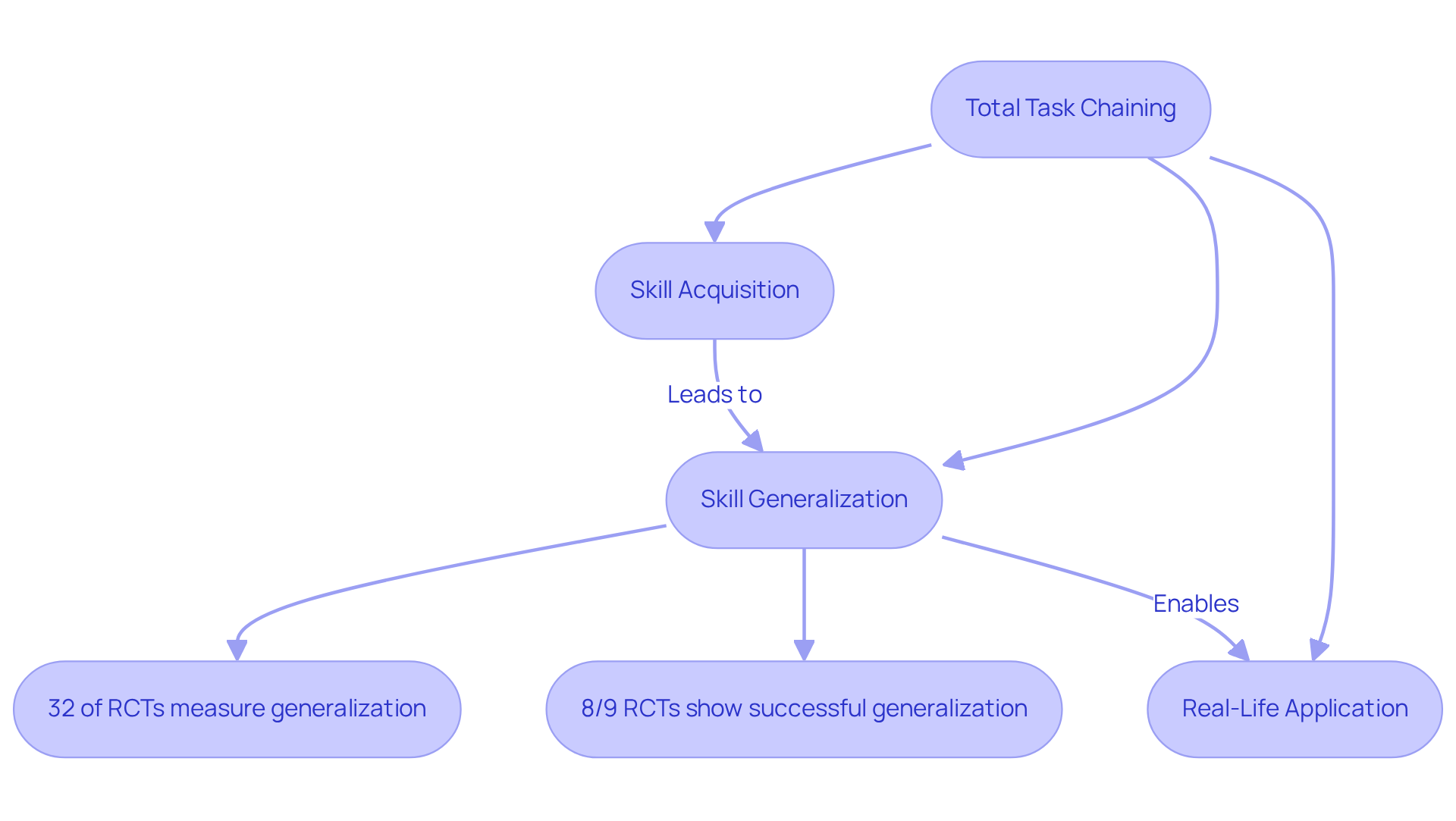
Overall activity linking significantly enhances communication abilities by fostering verbal exchanges during total task chaining. As individuals engage in tasks that necessitate communication, they cultivate essential skills such as:
This approach not only facilitates the development of but also plays a pivotal role in their overall social development. For instance, children practicing comprehensive task sequencing have shown remarkable progress in their ability to express needs and interact with peers, leading to more meaningful social engagements.
Research confirms that engagement in tasks through total task chaining is directly correlated with improved communication abilities, highlighting the importance of structured verbal interactions in ABA therapy. Case studies reveal that individuals who consistently apply these skills through Complete Assignment Linking experience significant enhancements in their communication capabilities, further demonstrating the method's effectiveness in fostering vital social skills.
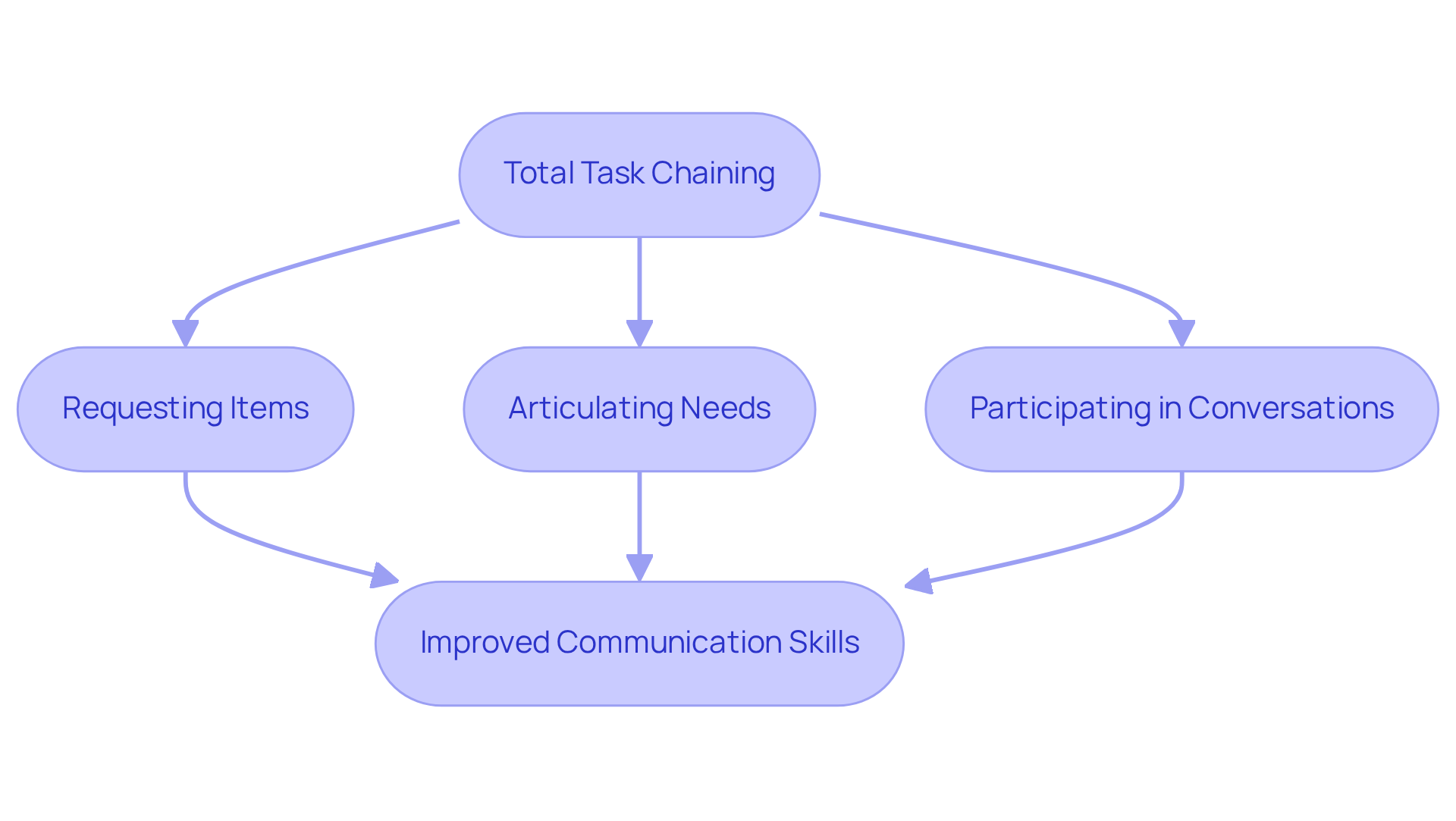
The demand for is underscored by a projected growth rate of 16% for Registered Behavior Technicians (RBTs) and 17% for assistant behavior analysts (BCaBAs). Total Task Chaining significantly improves collaboration between therapists and individuals, fostering a shared understanding of the tasks being learned. As individuals engage in the entire task, such as making a sandwich or setting the table, therapists can provide prompt feedback and support, cultivating a dynamic learning environment. This method allows therapists to observe the learner's progress in real-time, facilitating timely interventions and adjustments to the teaching strategy.
The collaborative nature of this approach not only strengthens the therapist-participant relationship but also promotes better learning outcomes. Individuals feel more involved and empowered in their learning journey. For instance, when a learner practices all steps of a task, therapists can reinforce successful completions with positive feedback, which builds confidence and motivation. As noted by Cooper, Heron & Heward, this approach promotes a holistic understanding of the task and potentially accelerates learning by integrating all components.
This synergy between therapist and client is crucial, as it encourages open communication and fosters a supportive atmosphere. Ultimately, this leads to improved behavioral outcomes and skill mastery. Moreover, active caregiver involvement is essential; remarkable progress is observed in 90% of individuals when recommended hours are fully implemented with their participation. Are you facing challenges in hiring qualified professionals? Consider how effective collaboration can transform your therapy practices and enhance outcomes for those you serve.
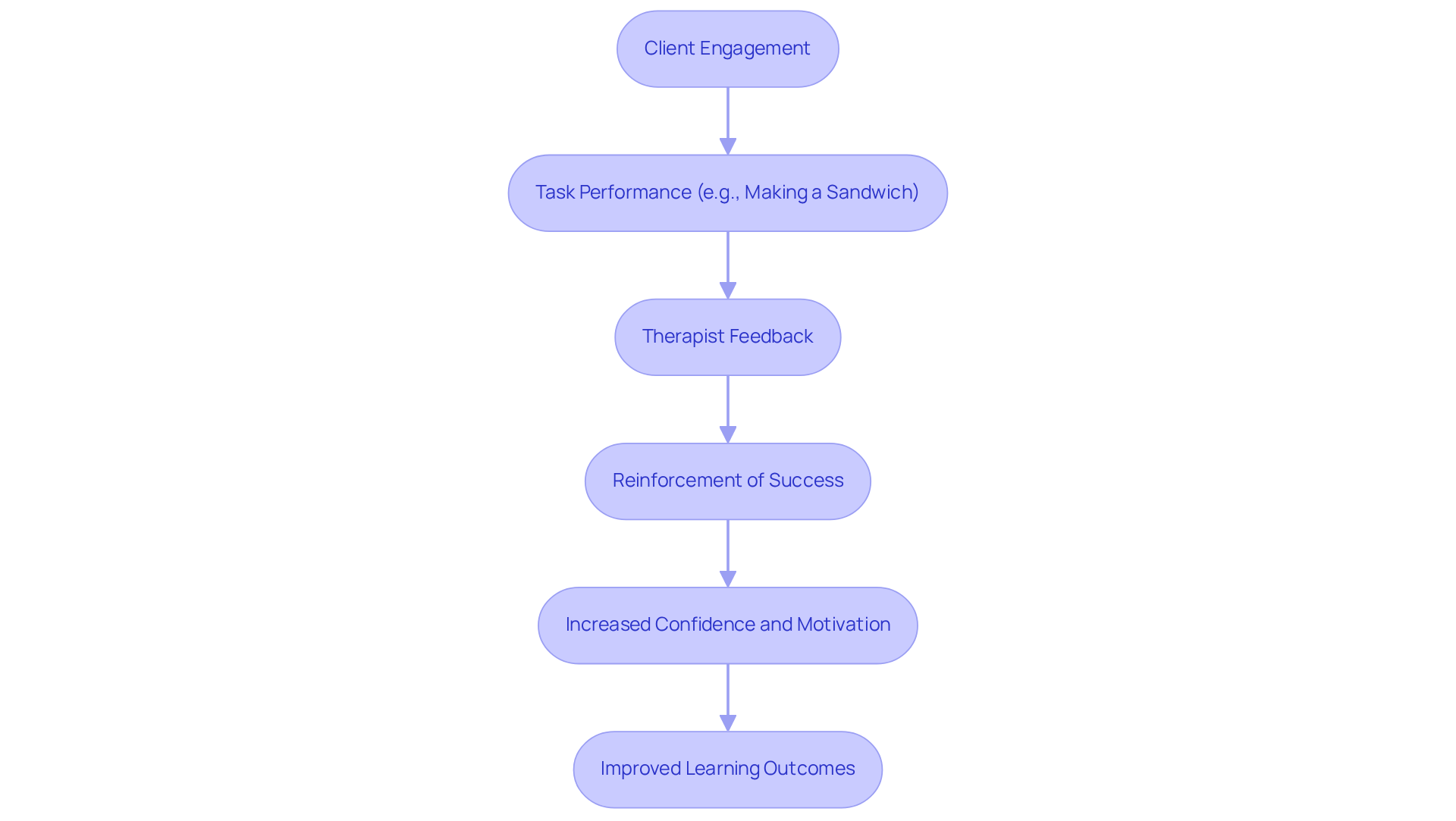
Total task chaining emerges as a transformative approach in ABA therapy, fundamentally enhancing skill acquisition, independence, and overall client engagement. By allowing individuals to engage with tasks in their entirety, this method fosters a deeper understanding of the interconnected steps and promotes the practical application of learned skills in real-world scenarios.
The article outlines several key benefits of total task chaining, including:
This structured method accommodates diverse learning styles, ensuring that each individual receives tailored support that resonates with their unique needs. Additionally, the collaborative nature of total task chaining strengthens the relationship between therapists and clients, leading to more effective interventions and better behavioral outcomes.
In light of these insights, it is vital for practitioners and caregivers to consider the implementation of total task chaining in their ABA practices. By embracing this holistic approach, they can significantly improve the quality of therapy, empower individuals with essential life skills, and ultimately enhance the overall effectiveness of ABA interventions. The future of ABA therapy lies in methods that not only teach but also inspire confidence and independence in those they serve.
What is Hire ABA and what does it offer?
Hire ABA is a specialized recruitment platform that connects Board Certified Behavior Analysts (BCBAs) with top-tier job opportunities, streamlining the hiring process through personalized resume assessments and advanced job fit scoring.
Why has the demand for BCBAs increased?
The demand for BCBAs has surged dramatically, with a 1,942% increase from 2010 to 2018, and it is projected to rise by an additional 25% by 2026 due to the expanding field of Applied Behavior Analysis (ABA) therapy.
How does Hire ABA improve the hiring process?
Hire ABA improves the hiring process by ensuring that skilled individuals are matched with roles that align with their expertise and career aspirations, enhancing the quality of care in ABA therapy environments.
What regional variations exist in the demand for BCBAs?
In 2023, California accounted for 18% of the demand for BCBAs, indicating significant regional differences that healthcare employers need to consider in their recruitment strategies.
What is Total Task Chaining and how does it benefit learners?
Total Task Chaining is a method within ABA therapy that enhances skill development by allowing learners to engage in tasks from start to finish, promoting better understanding, skill retention, and application of learned behaviors in real-life situations.
What are the advantages of using Total Task Chaining in ABA therapy?
The advantages include improved skill retention, enhanced generalization of abilities, and the development of independence, as learners become more adept at applying their skills in various environments.
How important is caregiver involvement in the Total Task Chaining process?
Ongoing participation from caregivers is vital, as their involvement significantly enhances the efficacy of comprehensive task sequences and supports the learner's development.
What evidence supports the effectiveness of ABA therapy methods like Total Task Chaining?
Research indicates that up to 90% of youth undergoing ABA therapy show noticeable improvements in their target behaviors, although only 4% of studies on ABA therapy included control groups, raising questions about the robustness of these findings.
How does Total Task Chaining promote independence in clients?
Total Task Chaining empowers individuals to complete tasks independently, fostering a sense of accomplishment and building confidence in their abilities, which enhances their overall development and quality of life.
What is the ongoing research gap related to ABA therapy?
There is a need for continued research to evaluate the long-term impact of ABA interventions on quality of life, ensuring that the methods remain effective and relevant for clients.
Our expert recruitment strategies and AI-driven sourcing ensure that you receive top-notch candidates quickly, without compromising on quality. Whether you’re looking for BCBAs, Clinical Directors, or RBTs, we’ve got you covered.